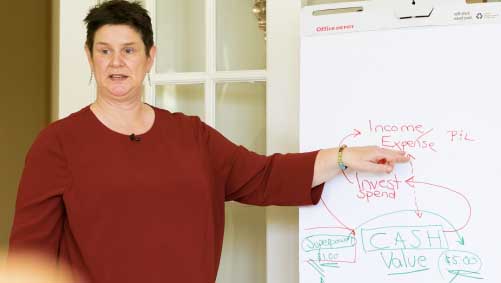
The Tiny Injury That Exposed a Huge Weakness in My Business
What if one small accident could derail your entire business?
Recently, one of my team members—and close family—broke their right hand.
Yes, their dominant one. The one used for everything from replying to emails, designing graphics, and editing our fantastic podcast clips.
(And let me tell you, nothing brings the phrase “business continuity” into sharper focus than watching someone you care about try to navigate Google Sheets or Canva with their non-dominant hand.)
Our business rhythm skipped a beat. Deadlines shifted. Routines collapsed.
And I learned firsthand just how fragile autonomy can be—for one person and an entire team.
It opened my eyes to how vulnerable we are to everyday chaos, and it challenged me to ask:
What happens when your key players can’t play? Are we building businesses that thrive on people—or survive without them?
When Autonomy Disappears
Wen’s injury wasn’t just a personal inconvenience—it was a flashing red light for our business.
Suddenly, the person we relied on for social media, customer communication, and half of our operational tasks couldn’t type, and could barely click or swipe.
And here’s the real kicker: none of this was Wen’s fault.
The disruption revealed a core weakness—our over-reliance on individual know-how instead of scalable, shareable systems.
In small businesses, it’s easy to become dependent on the “rock stars” on your team. But when even one of those stars goes down—temporarily or not—the business shouldn’t go with them.
Small business resilience isn’t about who can hustle the hardest. It’s about how well your systems can stand on their own.
If you’re relying on memory, sticky notes, or one person’s inbox to hold your business together, you’re walking a tightrope with no net.
What Systems Are (And Aren’t)
Systems aren’t just fancy software. They’re repeatable processes, clearly documented steps, and shared knowledge that keeps the business moving, even when life doesn’t go according to plan.
A system can be a checklist in Notion, a Loom video walkthrough, or even a printed “How-To” binder if that’s your jam.
What matters is that someone else can jump in without panic or guesswork.
✅ Action Tip: Run the “Out Sick” Test
Choose one key team member—maybe even yourself—and imagine they’re out for a week with zero access to their usual tools. Then ask:
- What critical tasks go undone?
- Who knows how to step in?
- Is there a reference or guide they can use?
- Would a temporary contractor know what to do?
This low-tech, high-impact drill can be the difference between a brief hiccup and a full-blown business stall.
And it will show you—clearly—where you need to build or bolster your systems.
Time Management Tips—With One Hand Tied?
We were suddenly faced with an uncomfortable truth: our “perfectly manageable” task list was only manageable under ideal conditions.
As it turns out, most small business workflows are designed for best-case scenarios—not when someone is slowed down or out altogether.
We had to:
- Reassess priorities
- Reassign tasks
- Let a few things go (hard truth: not everything can—or should—be done right now)
That’s not failure. That’s triage.
✅ Action Tip: Create a “Priority Triage List” Every Monday (10 Minutes Max)
Ask yourself and your team:
- What three things must get done this week?
- What can be delayed?
- Who else can take on a task—even temporarily?
Bonus: Track recurring tasks that eat up the most time. Those are great candidates for automation or delegation.
What Gen Z Teammates Reveal About Your Systems
Gen Z employees are tech-savvy and adaptive—Wen is a great example.
This generation brings immense value: they’re intuitive with tech, fluent in new platforms, and naturally collaborative.
But they also thrive on flexibility, clear communication, and mental health-conscious workplaces. They want to contribute meaningfully—not be a single point of failure.
Even the most resourceful team member is human. When life hits, when fingers break, when technology goes haywire, even your MVPs need support.
🧠 Action Tip: Support Your Gen Z MVPs (Before You Need To)
- Cross-train your team. Even a quick “How I do this” Loom video on can create powerful backups.
- Create micro-SOPs. Short, bullet-point how-to’s in a shared folder are lifesavers.
- Encourage knowledge-sharing. During weekly meetings, let team members teach each other a tool or shortcut they use.
And when you’re recruiting Gen Z talent, don’t just sell them on your mission—show them your backup plan.
Ask them what they need to thrive—not just tech tools, but mental health resources, flexible work protocols, and accessible training guides.
Show them you value sustainability (for them and the business), and that you’re investing in systems—not just superstars.
Reflecting on the Fragile and the Foundational
Watching Wen navigate everyday tasks one-handed made something painfully clear: autonomy is a gift. Yet it’s also a risk if we build our businesses assuming it’ll always be there.
As small business owners, we wear a dozen hats and often work alongside a small, mighty team who do the same. But this experience forced me to ask a deeper question:
Are we building a business that thrives only when everything goes right?
The fragile part of our business? Our over-reliance on people over process.
The foundational part? Our values. Our willingness to pivot. Our commitment to resilience.
So, here’s your takeaway: Your business isn’t invincible, but it can be adaptable.
If you’ve ever asked yourself, “What would happen if I (or my star employee) couldn’t work tomorrow?”—don’t wait for an ER visit to find out. 🦴🩻
Have you ever faced a sudden disruption in your business? What systems or surprises came out of it?
Share your story in the comments—or better yet, forward this to the friend who always says, “I’ll figure it out later.”
I challenge you—right now—to open up a doc and write down ONE process you rely on every week.
Just one.
That tiny effort could save your business next time life throws a curveball.
You’ll thank me later.

Pam Prior
Author, Virtual CFO, and Finance Coach
“Your First CFO: The Accounting Cure for Small Business Owners” on AMAZON
“Founder to Exit: A CFO’s Blueprint for Small Business Owners” on AMAZON
***Disclaimer: This post is for informational purposes only and does not constitute financial or legal advice. Consult with a professional before making any financial decisions.





